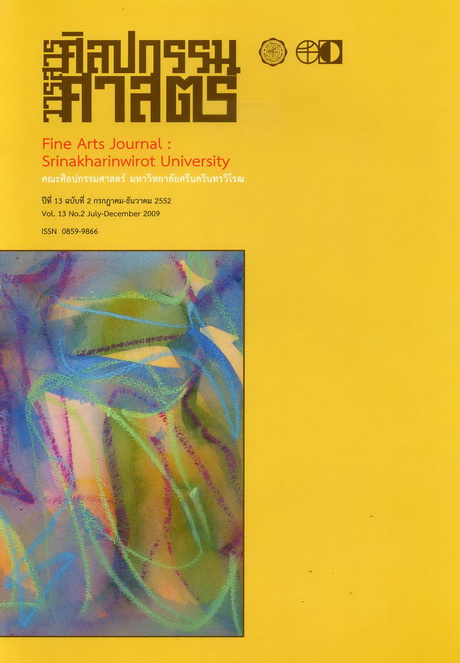The Study of the Ornament of the Sino - Portuguese Architecture and the Ornament of the Lanna Architecture for Integration of Jewelry Design for Industry
Abstract
The study of the ornament of the Sino - Portuguese Architecture and the ornament of the Lanna Architecture for integration of jewelry design for industry could be discussed in the following subjects :
1. The ornament structures. The Sino - Portuguese Architecture in Phuket and the Lanna Architecture in Chiang Mai are mostly in triangle forms and have the same ornament structures namely triangle, rectangle, and trapezium. The ornament is encompassed within the defined area and so created in accordance with the specified area.
2. The influence appearing on the ornament. The Sino - Portuguese Architecture is influenced by many foreign nations, especially the western fine art such as Ancient Greek -Roman Art era, Renaissance era or Revival Art era, Neo -Classic Art era and the influence of belief in the Portuguese Art, which is also influenced by English and French art. The only obvious influence of eastern nation in the Sino - Portuguese Architecture is Chinese. This influence is so distinctive that it could integrate the different art patterns and mingle into the new ornament of the Sino - Portuguese Architecture perfectly. The significant influences in the ornament of the Lanna Architecture in Chiang Mai are arts from India, Khmer, and Myanmar or Phu - gam. However, the only distinctive influence is Myanmar or Phu - gam; no influence of the western art could be seen in the sampling groups of the Lanna Art.
3. The similarities of configuration of the Sino - Portuguese Architecture in Phuket Province and of the Lanna Architecture in Chiang Mai could be separated into 3 types as follows:
Symmetry -Balancing the ornament at the right side and the left side equally.
Having the ornament fixed in the middle to anchor tracery on both sides.
Unity -Having the ornament fixed in the middle to anchor the ornament on both sides.
Asymmetry -Arranging the ornament on the left side and the right side unequally. The ornaments are in different patterns but placed in the same direction or arranged in different sizes; some are small and some are big.
The solution for background area problem of the Sino - Portuguese Architecture is balancing the figure and background equally and not providing too many ornaments on which some space of the background is left in order to make it sparse. Unlike the solution for the Lanna Architecture, the figure is more emphasized than the background. Therefore, the ornament is fully filled on the area of the background more than the ornament of the Sino - Portuguese Architecture.
โครงการวิจัยการศึกษาลวดลายตกแต่งสถาปัตยกรรมชิโน- โปรตุกีส และลวดลายตกแต่งสถาปัตยกรรมล้านนา เพื่อบูรณาการการออกแบบเครื่องประดับอุตสาหกรรม
การศึกษาลวดลายตกแต่งสถาปัตยกรรมชิโนโปรตุกีสและลวดลายตกแต่งสถาปัตยกรรมล้านนาเพื่อบูรณาการการ ออกแบบเครื่องประดับอุตสาหกรรมนั้น จากการศึกษาแยกเป็นประเด็นได้ดังนี้
1.โครงสร้างของลวดลายตกแต่งสถาปัตยกรรมชิโน- โปรตุกีสที่จังหวัดภูเก็ต และลวดลายตกแต่งสถาปัตยกรรมล้าน นา ที่จังหวัดเชียงใหม่ มีโครงสร้างอยู่ในรูปสามเหลี่ยมมากกว่าโครงสร้างอื่น และมีโครงสร้างของลวดลายเหมือนกัน คือ โครงสร้างสามเหลี่ยม สี่เหลี่ยมผืนผ้า สี่เหลี่ยมด้านไม่เท่า ลวดลายอยู่ในพื้นที่ที่ถูกกำหนดไว้ก่อน ลวดลายจึงตกแต่งตาม ขนาดของพื้นที่ที่ถูกกำหนดไว้
2. อิทธิพลที่ปรากฏในลวดลาย ลวดลายตกแต่งสถาปัตยกรรมชิโน - โปรตุกีส ได้อิทธิพลของต่างชาติหลายชาติ โดยเฉพาะอิทธิพลจากศิลปกรรมชาติตะวันตก เช่น อิทธิพลศิลปกรรมกรีก - โรมันโบราณ อิทธิพลศิลปกรรมสมัยเรอนา ซองส์หรือสมัยฟื้นฟูศิลปวิทยาการ อิทธิพลศิลปกรรมสมัยนีโอคลาสสิค อิทธิพลจากความเชื่อที่อยู่ในงานศิลปกรรมของ โปรตุเกส ซึ่งได้อิทธิพลที่อยู่ในงานของศิลปกรรมอังกฤษและฝรั่งเศส อิทธิพลที่มาจากตะวันออกที่เห็นชัดเจนมีชาติเดียวคือ จีน แต่ความเชื่อแห่งวัฒนธรรมและศิลปกรรมจีนกลับโดดเด่นชัดเจนมาก แสดงถึงอิทธิพลของศิลปกรรมจีนที่สามารถ เปลี่ยนรูปแบบเป็นลวดลายที่บูรณาการความแตกต่างให้สามารถกลมกลืนทั้งในลวดลายและโครงสร้างในงานสถาปัตยกรรม ชิโน - โปรตุกีสได้อย่างลงตัว สำหรับงานตกแต่งสถาปัตยกรรมล้านนาที่จังหวัดเชียงใหม่นั้น อิทธิพลที่ชัดเจน ได้แก่ ศิลปกรรมอินเดีย เขมร และพม่าหรือพุกาม อิทธิพลจากพม่าหรือพุกามเป็นอิทธิพลที่เห็นได้ชัด ไม่มีอิทธิพลของศิลปกรรม ตะวันตกปรากฏให้เห็นในลวดลายล้านนาที่เลือกเป็นกลุ่มตัวอย่าง
3. การจัดองค์ประกอบของลวดลายตกแต่งสถาปัตยกรรมชิโน - โปรตุกีสที่จังหวัดภูเก็ต และลวดลายตกแต่ง สถาปัตยกรรมล้านนาที่จังหวัดเชียงใหม่มีการจัดองค์ประกอบเหมือนกันสามแบบ คือ การจัดองค์ประกอบแบบสมมาตร (Symmetry) โดยการจัดองค์ประกอบให้น้ำหนักซ้ายขวาเท่ากัน ให้ลวดลายตรงกลางยึดเหนี่ยวลายทั้งสองข้าง และการจัด องค์ประกอบให้น้ำหนักซ้ายขวาไม่เท่ากัน (Asymmetry) โดยใช้วิธีการให้ลวดลายไม่เหมือนกัน แต่วางน้ำหนักของทิศทาง เหมือนกัน หรือให้ขนาดของลวดลายแต่ละลายเล็กใหญ่ไม่เท่ากัน การแก้ปัญหาพื้นที่ลวดลายตกแต่งสถาปัตยกรรมชิโน - โปรตุกีสให้ความสมดุลระหว่างรูปและพื้นเท่ากัน โดยให้ลวดลายไม่แน่นมาก ให้มีความโปร่งเห็นส่วนที่เป็นพื้น ซึ่งแตกต่าง จากการแก้ปัญหาพื้นที่ลวดลายตกแต่งสถาปัตยกรรมล้านนาที่ให้ความสำคัญของส่วนที่เป็นรูปมากกว่าส่วนที่เป็นพื้นหลัง ลวดลายจึงมีความแน่นละเอียดวางเต็มพื้นที่มากกว่าลวดลายตกแต่งสถาปัตยกรรมชิโน- โปรตุกีส






